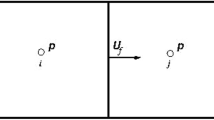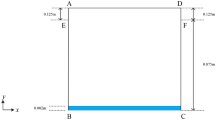Abstract
Local maximum entropy (LME) meshfree basis functions are among the few approximants that possess the Kronecker delta property on the boundary, which enable to impose the essential boundary conditions directly like FEM. This study presents the potential of a meshfree method based on LME approximation for the Convection–Diffusion problem via well-celebrated SUPG. The present LME based Streamline Upwind Petrov–Galerkin meshfree method (SUPGM) benefits from the advantages emanated from both methods. LME approximants accounts for the disposal of the elements and direct imposition of boundary conditions and the SUPGM technique to deal with the issues associated with the non-self-adjoint convective term. Two standard benchmark problems are considered to validate the LME-SUPGM. The effect of different priors and radius of support that defines the LME basis are studied to test their importance in the present method. It is found that a balance between stability and accuracy is possible with ease by tuning the effective radius of support for LME for the given problem. The present method converges faster than FEM-SUPG and provides a smooth solution relatively.















Similar content being viewed by others
References
Belytschko T, Lu YY, Gu L (1994) Element-free Galerkin methods. Int J Numer Methods Eng 37:229–256. https://doi.org/10.1002/nme.1620370205
Atluri SN, Zhu T (1998) A new Meshless local Petrov-Galerkin (MLPG) approach in computational mechanics. Comput Mech 22:117–127. https://doi.org/10.1007/s004660050346
Ghehsareh HR, Raei M, Zaghian A (2019) Application of meshless local Petrov–Galerkin technique to simulate two-dimensional time-fractional Tricomi-type problem. J Braz Soc Mech Sci Eng 41:252. https://doi.org/10.1007/s40430-019-1749-0
Fries T-P, Matthies HG (2004) Classification and Overview of Meshfree Methods. Inform der Tech Univ Braunschweig 2003–03
Zhang T, Li X (2018) A generalized element-free Galerkin method for Stokes problem. Comput Math Appl 75:3127–3138. https://doi.org/10.1016/j.camwa.2018.01.035
Sukumar N (2004) Construction of polygonal interpolants: a maximum entropy approach. Int J Numer Methods Eng 61:2159–2181. https://doi.org/10.1002/nme.1193
Sukumar N, Wright RW (2007) Overview and construction of meshfree basis functions : from moving least squares to entropy approximants, pp 181–205. https://doi.org/10.1002/nme
Arroyo M, Ortiz M (2006) Local maximum-entropy approximation schemes : a seamless bridge between finite elements and meshfree methods. Int J Numer Methods Eng 63:2167–2202. https://doi.org/10.1002/nme.1534
Masud A, Khurram RA (2004) A multiscale/stabilized finite element method for the advection–diffusion equation. Comput Methods Appl Mech Eng 193:1997–2018. https://doi.org/10.1016/j.cma.2003.12.047
Brezzi F, Franca LP, Hughes TJR, Russo A (1997) b = ∝ g. Comput Methods Appl Mech Eng 145:329–339. https://doi.org/10.1016/S0045-7825(96)01221-2
John V, Knobloch P, Novo J (2018) Finite elements for scalar convection-dominated equations and incompressible flow problems: a never ending story? Comput Vis Sci 19:47–63. https://doi.org/10.1007/s00791-018-0290-5
Brooks AN, Hughes TJR (1982) Streamline upwind/Petrov–Galerkin formulations for convection dominated flows with particular emphasis on the incompressible Navier–Stokes equations. Comput Methods Appl Mech Eng 32:199–259. https://doi.org/10.1016/0045-7825(82)90071-8
Lima RC, Mesquita ALA, Blanco CJC et al (2014) On the application of SUPG/θ-method in 2D advection–diffusion-reaction simulation. J Braz Soc Mech Sci Eng 36:591–603. https://doi.org/10.1007/s40430-013-0099-6
Franca LP, Frey SL, Hughes TJR (1992) Stabilized finite element methods: I. Application to the advective-diffusive model. Comput Methods Appl Mech Eng 95:253–276. https://doi.org/10.1016/0045-7825(92)90143-8
Hughes TJR, Scovazzi G, Franca LP (2017) Multiscale and stabilized methods. In: Encyclopedia of computational mechanics second edition. American Cancer Society, pp 1–64
Brezzi F, Marini D, Russo A (1998) Applications of the pseudo residual-free bubbles to the stabilization of convection-diffusion problems. Comput Methods Appl Mech Eng 166:51–63. https://doi.org/10.1016/S0045-7825(98)00082-6
Hughes TJR (1995) Multiscale phenomena: Green’s functions, the Dirichlet-to-Neumann formulation, subgrid scale models, bubbles and the origins of stabilized methods. Comput Methods Appl Mech Eng 127:387–401. https://doi.org/10.1016/0045-7825(95)00844-9
Hughes TJR, Mazzei L, Oberai AA, Wray AA (2001) The multiscale formulation of large eddy simulation: decay of homogeneous isotropic turbulence. Phys Fluids 13:505–512. https://doi.org/10.1063/1.1332391
Shishkin GI, Roos H-G, Stynes M, Tobiska L (1997) Numerical methods for singularly perturbed differential equations. Convection–diffusion and flow problems. Berlin etc., Springer-Verlag 1996. XVI, 348 pp., DM 148,00. ISBN 3-540-60718-8 (Springer Series in Computation. ZAMM J Appl Math Mech/Zeitschrift für Angew Math und Mech 77:403. https://doi.org/10.1002/zamm.19970770525
Lin H, N Atluri S (2000) Meshless local Petrov–Galerkin (MLPG) Method for convection–diffusion problems. C Comput Model Eng Sci 1
Ouyang J, Zhang L, Zhang X (2007) Nonstandard element free Galerkin method for solving unsteady convection dominated problems. Acta Aerodyn Sin 25:287–293
Khankham S, Luadsong A, Aschariyaphotha N (2015) MLPG method based on moving kriging interpolation for solving convection–diffusion equations with integral condition. J King Saud Univ Sci 27:292–301. https://doi.org/10.1016/j.jksus.2015.03.001
Wu X-H, Dai Y-J, Tao W-Q (2012) MLPG/SUPG Method for convection-dominated problems. Numer Heat Transf Part B Fundam 61:36–51. https://doi.org/10.1080/10407790.2011.630962
Hong CTWDLYHK (2014) Adaptive meshless local maximum-entropy finite element method for convection–diffusion problems, pp 189–200. https://doi.org/10.1007/s00466-013-0901-4
Cyron CJ, Nissen K, Gravemeier V, Wall WA (2010) Information flux maximum-entropy approximation schemes for convection–diffusion problems. Int J Numer Methods Fluids 64:1180–1200. https://doi.org/10.1002/fld.2271
Nissen K, Wall WA (2016) Pressure-stabilized maximum-entropy methods for incompressible Stokes. Int J Numer Methods Fluids 82:35–56. https://doi.org/10.1002/fld.4205
Nissen K, Cyron C, Gravemeier V, Wall W (2012) Information-flux method: a meshfree maximum-entropy Petrov-Galerkin method including stabilised finite element methods. Comput Methods Appl Mech Eng s 241–244:225–237. https://doi.org/10.1016/j.cma.2012.05.015
Sukumar N (2005) Maximum entropy approximation
Ortiz A, Puso MA, Sukumar N (2010) Maximum-entropy meshfree method for compressible and near-incompressible elasticity. Comput Methods Appl Mech Eng 199:1859–1871. https://doi.org/10.1016/j.cma.2010.02.013
Hughes TJR, Franca LP, Balestra M (1986) A new finite element formulation for computational fluid dynamics: V. Circumventing the babuška-brezzi condition: a stable Petrov–Galerkin formulation of the stokes problem accommodating equal-order interpolations. Comput Methods Appl Mech Eng 59:85–99. https://doi.org/10.1016/0045-7825(86)90025-3
Franca LP, Hauke G, Masud A (2006) Revisiting stabilized finite element methods for the advective–diffusive equation. Comput Methods Appl Mech Eng 195:1560–1572. https://doi.org/10.1016/j.cma.2005.05.028
Hughes TJR, Franca LP, Hulbert GM (1989) A new finite element formulation for computational fluid dynamics: VIII. The galerkin/least-squares method for advective-diffusive equations. Comput Methods Appl Mech Eng 73:173–189. https://doi.org/10.1016/0045-7825(89)90111-4
Peddavarapu S, Raghuraman S (2020) Maximum entropy-based variational multiscale element-free Galerkin methods for scalar advection–diffusion problems. J Therm Anal Calorim. https://doi.org/10.1007/s10973-020-09845-y
Sukumar N, Moran B, Belytschko T (1998) The natural element method in solid mechanics. Int J Numer Methods Eng 887:839–887
Leonard BP (1988) Simple high-accuracy resolution program for convective modelling of discontinuities. Int J Numer Methods Fluids 8:1291–1318. https://doi.org/10.1002/fld.1650081013
Peco C, Millán D, Rosolen A, Arroyo M (2015) Efficient implementation of Galerkin meshfree methods for large-scale problems with an emphasis on maximum entropy approximants. Comput Struct 150:52–62. https://doi.org/10.1016/j.compstruc.2014.12.005
Chen Z-J, Li Z-Y, Wu X-H, Tao W-Q (2018) A meshless local Petrov–Galerkin approach for solving the convection-dominated problems based on the streamline upwind idea and the variational multiscale concept. Numer Heat Transf Part B Fundam 73:19–32. https://doi.org/10.1080/10407790.2017.1420320
Ortiz-bernardin A, Hale JS (2015) Cyron CJ Volume-averaged nodal projection method for nearly-incompressible elasticity using meshfree and bubble basis functions. Comput Method Appl Mech Eng 56:1–52
Author information
Authors and Affiliations
Corresponding author
Ethics declarations
Conflict of interest
The authors declare that there is no conflict of interest.
Additional information
Technical Editor: Monica Carvalho.
Publisher's Note
Springer Nature remains neutral with regard to jurisdictional claims in published maps and institutional affiliations.
Rights and permissions
About this article
Cite this article
Peddavarapu, S., Srinivasan, R. Local maximum entropy approximation-based streamline upwind Petrov–Galerkin meshfree method for convection–diffusion problem. J Braz. Soc. Mech. Sci. Eng. 43, 326 (2021). https://doi.org/10.1007/s40430-021-03038-w
Received:
Accepted:
Published:
DOI: https://doi.org/10.1007/s40430-021-03038-w




